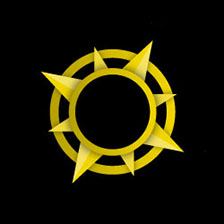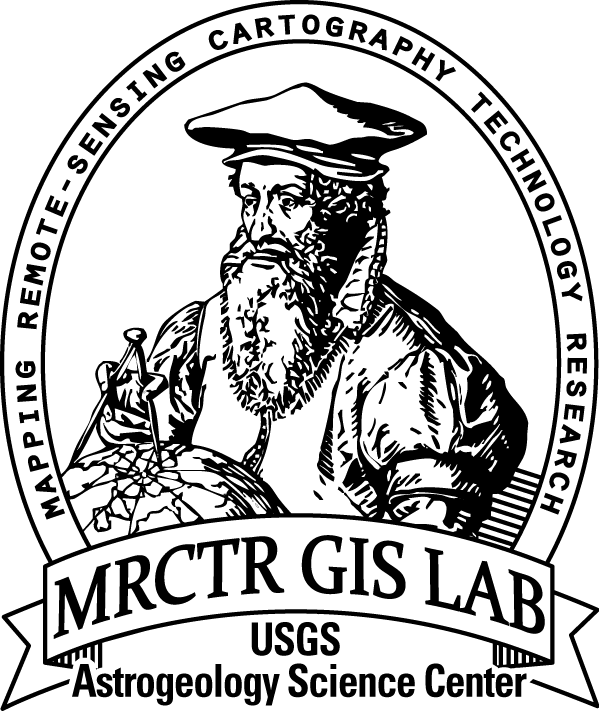Project Overview
The goal of this research project is to advance our understanding of pyroclastic volcanism on the Moon using remote sensing data, primarily the high-spatial-resolution (~100 m/pixel) DOD/NASA Clementine data from the UVVIS (ultraviolet/visible) camera. These global multispectral data allow us to map the distributions and to characterize the compositions of these deposits in unprecedented detail. Compositional analyses of these deposits may provide clues to the nature of deep-source, early-stage volcanism and eruption mechanisms on the Moon. The work consists of 5 tasks: (1) compilation and evaluation of a global inventory of pyroclastic material distributions and compositions; (2) characterization of the relations between and among pyroclastic and nearby mare and/or cryptomare deposits; (3) establishment of a chronologic database of relative emplacement ages of pyroclastic materials; (4) evaluation of lunar pyroclastic eruptive styles; and (5) examination of the influence of local and regional tectonics and structure on the observed spatial distribution, composition, and inferred eruptive styles of these deposits.
We used the USGS ISIS software (Eliason, 1997; Gaddis et al., 1997; Torson and Becker, 1997) to create and examine Clementine UVVIS multispectral mosaics (~100 m/pixel) of 5 of the major large pyroclastic deposits and 15 small deposits from the three major compositional classes (e.g., Hawke et al., 1989). Our objectives are (1) to understand the full extent of interdeposit compositional variations among lunar pyroclastic deposits; (2) to evaluate the possible effects of soil maturation and lateral mixing on the "true" compositions of these deposits; (3) to determine the prevalence and nature of intradeposit compositional variations previously observed in deposits such as that of Alphonsus Crater (Coombs et al., 1990); (4) to identify and characterize the juvenile components of these deposits; and (5) to understand the implications of these results for studying lunar eruption mechanisms.
Data Processing
The Clementine data were obtained by the UVVIS camera at 5 wavelengths: 415, 750, 900, 950, and 1000 nm. ISIS processing of the raw Clementine data included: offset and gain corrections, dark-current subtraction, readout correction, flat-field corrections, subpixel-level coregistration, projection to Sinusoidal Equal-Area, photometric normalization (to standard viewing angles of phase=30 degrees, emission=0 degrees, and incidence=30 degrees) and automated mosaicking. The data were calibrated from digital numbers to bidirectional reflectance (percent reflectance) to facilitate compositional analyses (McEwen, 1991; McEwen, 1996; Pieters et al., 1997; McEwen et al., 1998; Eliason et al., 1999; Robinson et al., 1999).
Previous Work
Lunar pyroclastic materials, primarily the juvenile picritic glasses, provide unique information on the composition of the mantle (e.g., Delano, 1986) and the nature and origin of associated volatile elements in an otherwise volatile-depleted environment (e.g., Heiken et al., 1974). Possible fundamental differences between picritic glasses and mare basalts (e.g., lesser fractional crystallization and greater depth of origin for glasses; Shearer and Papike, 1993) support their identification as the best examples of primitive materials on the Moon and attest to their importance in characterizing the lunar interior and as a starting place for understanding the origin and evolution of basaltic magmatism on the Moon. Remote sensing analyses of these deposits have helped us to identify the characteristic components of some of these deposits (e.g., Gaddiset al., 1985 and references therein), to constrain the distribution of lunar volcanic deposits (Head, 1974), and to understand the styles of eruption and emplacement of basalts on the Moon (Wilson and Head, 1981). To fully appreciate the role of pyroclastic volcanism on the Moon, we must understand the ranges of composition, spatial and temporal distribution, relationship to effusive volcanic deposits, and modes of formation of pyroclastic deposits. Until additional samples are available, remote analyses of lunar pyroclastic deposits are the only means of fully characterizing these deposits.
Nearly 100 lunar pyroclastic deposits have been recognized (e.g., Gaddis et al., 1985; Hawke et al., 1989; Coombs and Hawke, 1992). They are commonly dark and smooth-surfaced, and they are observed in association with sinuous rilles, irregular depressions, or endogenic craters within highlands and/or the floors of old impact craters situated along the margins of many of the major mare-filled impact basins on the lunar near side. A small number of pyroclastic deposits have been found on the lunar far side; examples are found in the floor of Schrodinger Crater (Shoemaker et al., 1994) and in the Apollo Basin within the far side South Pole/Aitken Basin (Robinson et al., 1996). Lunar pyroclastic deposits have been subdivided into "regional" and "localized" deposits on the basis of size, morphology, and occurrence; the large regional deposits can be up to several 1000 km2 in size, while localized or small pyroclastic deposits are typically less than 1000 km2 in size (Gaddis et al., 1985). Regional deposits are thought to have been emplaced as products of fire-fountain or Strombolian-style eruptions, with wide dispersion of well-sorted pyroclasts (Wilson and Head, 1981; Head and Wilson, 1992; Head et al., 1997). Analyses of Apollo samples and Earth-based spectral reflectance studies have identified a significant component of Fe2+-bearing volcanic glass beads in many of the regional pyroclastic deposits (e.g., Pieters et al., 1973, 1974; Adams et al., 1974; Gaddis et al., 1985; Lucey et al., 1986; Hawke et al., 1991; Weitz et al., 1998).
Intermittently explosive or Vulcanian-style eruptions are likely to have produced the small pyroclastic deposits, with explosive decompression acting to remove a plug of lava within a conduit and to form an endogenic vent crater (Head and Wilson, 1979). The small pyroclastic deposits have been further subdivided into three compositional classes on the basis of their "1.0-micron" or mafic absorption bands in Earth-based spectra (e.g., Hawke et al., 1989; Table 1). Mafic bands of small pyroclastic deposits in the Group 1 class are centered near 0.93 to 0.95 microns, have depths of 4 to 5%, and are asymmetrical, with "checkmark"-like shapes (straight, steep, short-wavelength edges and shallow, straight, long-wavelength edges). Spectra for Group 1 deposits resemble those of typical highlands and are indicative of the presence of feldspar-bearing mafic assemblages which are dominated by orthopyroxene. Although compositional variation is observed within different Group 1 deposits, most appear to be mixtures of highlands-rich country rock and glass-rich juvenile material with small amounts of basaltic caprock material. Examples of Group 1 small pyroclastic deposits are found on the floors of Atlas Crater (45°N, 45°E), Franklin Crater (29°N, 48°E), and near Grimaldi Crater (1°S, 64°W). Mafic bands in spectra for Group 2 deposits are centered near 0.96 microns, have depths of ~7%, and are symmetrical in shape. Group 2 spectra are similar to those of mature mare deposits, and they are dominated by clinopyroxene. Small pyroclastic deposits in Group 2 appear to consist largely of fragmented plug rock material, with insignificant amounts of highland and juvenile materials. Examples of Group 2 deposits are the two small deposits east of Aristoteles Crater (50°N, 21°E and 28°E), and Rima Fresnel pyroclastics (28°N, 4°E). Group 3 mafic bands are centered near 1.0 micron, have depths of ~5 to 7%, are relatively broad and asymmetrical, and are probably multiple bands. Spectra of Group 3 deposits are dominated by olivine and orthopyroxene; the olivine is almost certainly associated with juvenile material, and the orthopyroxene is likely to have been emplaced as a result of erosion and entrainment of the wall rock (e.g., Hawke et al., 1989). Examples of Group 3 small pyroclastic deposits are those of J. Herschel Crater (62°N, 42°W), Alphonsus Crater (13°S, 4°W), and south of Cruger Crater (17.5°S, 67°W).
Table 1. Earth-based spectral classification of small lunar pyroclastic deposits (after Hawke et al., 1989).
| Group | Site | Mafic Band | Lithology |
| 1 |
Atlas S |
Ctr: ~0.94 m m |
mixed higlands wallrock (opx), |
| |
Franklin |
Depth: 4-5% |
glass-rich juvenile material, |
| |
Alphonsus W |
Asymmetrical |
lesser basaltic caprock (cpx) |
| 2 |
E. Frigoris W |
Ctr: 0.96 m m |
mostly fragmented basalt (cpx), |
| |
E. Frigoris E |
Depth: 7% |
little highlands and glassy |
| |
|
~Symmetrical |
material admixed |
| 3 |
J. Herschel |
Ctr: 1.0 m m |
juvenile material rich in |
| |
|
Depth: 5-7% |
olivine, admixed |
| |
|
Symmetrical |
highlands (opx) |
Results
Analyses of high-spatial resolution Clementine data have allowed us to develop a more complete picture of the global distribution of lunar pyroclastic deposits (Gaddis et al., 1998;), to identify new or previously unrecognized small pyroclastic deposits (Rosanova et al., 1998), and to characterize the range of pyroclastic material compositions (especially juvenile materials; Gaddis et al., 1997, 1999). Early efforts were focused on the small pyroclastic deposits because of their possible relative youth (~1 b.y.; Spudis, 1989), their broad global distribution, and the fact that their small sizes may have inhibited early Earth-based (~1 km footprint) telescopic spectral analyses. These analyses have complemented those of Weitz et al. (1998), who examined the major large pyroclastic deposits on the Moon.
Multispectral data from the Clementine UVVIS camera were used to examine the compositions of 18 pyroclastic deposits (15 small, 3 large) at 13 sites broadly distributed across the Moon (Gaddis et al., 1999). Tasks included: (1) determining the prevalence and nature of intradeposit compositional variations; (2) characterizing interdeposit compositional variations among small lunar pyroclastic deposits; (3) evaluating the effects of soil maturation and mixing on these deposits; (4) identifying and characterizing the juvenile components of these deposits; and (5) understanding the implications of these results for constraining lunar volcanic eruption mechanisms. We have the following results:
- Intradeposit compositional variations are observed between the two small pyroclastic deposits in the floor of Atlas crater. Mean mafic band strengths (as determined by the 950/750-nm ratio) for the two pyroclastic deposits are different than that of the subjacent highland terrain, and they are different from each other. These data suggest that there are two compositionally distinct pyroclastic deposits within a single vent area.
- Using Clementine color ratio data, we observe interdeposit compositional variations that are generally consistent with those of Hawke et al. (1989). Among the small pyroclastic deposits examined here, we can distinguish three compositional classes and we see the trend of increasing mafic absorption band strength from Group 1 to Group 2 to Group 3. However, with additional data the three classes are expected to aggregate into one or two groups with a range of 415/750 and 950/750 values, corresponding to mixtures of juvenile materials with mare and highland components. By analogy with the work of Hawke et al. (1989), Group 1 small pyroclastic deposits probably consist of feldspar-bearing mafic assemblages dominated by orthopyroxene, and they are likely to be mixtures of highlands-rich country rock, possible glass-rich juvenile material, and basaltic caprock material. Group 2 deposits, including the large deposit on Aristarchus Plateau, show strong affinities with mature mare deposits, dominated by clinopyroxene, and they may be fragmented plug rock material, with insignificant amounts of highlands and/or juvenile materials. The single Group 3 deposit at J. Herschel has the strongest mafic absorption band, and thus may show evidence of orthopyroxene and possibly olivine; the orthopyroxene is likely to have been emplaced as a result of erosion and entrainment of the wall rock, and the olivine may be associated with juvenile material.
- The compositions of the small pyroclastic deposits both resemble and differ markedly from those of the larger pyroclastic deposits. Two of the three large pyroclastic deposits included in this analysis fall within the 3-group spectral classification established for small pyroclastics. Although the Apollo 17/Taurus Littrow deposit has a very weak mafic band and is very blue in color (it falls well beyond the 3 classes observed for the small deposits), the Orientale annular pyroclastic deposit resembles the Group 1 small pyroclastics and many lunar highlands units, and Aristarchus show affinities with Group 2 small pyroclastic deposits and many mature lunar maria. Our results do not support those of Weitz et al. (1998), who suggest that the continuum of 415/750 and 950/750 values for the large pyroclastic deposits (starting at higher values and overlapping data for the small deposits at stronger mafic band strengths and redder colors) is a simple mixing line between deposits with quenched glass versus crystallized glass beads as dominant components. The observed overlap in color ratio data for these large and small pyroclastic deposits suggests that simple mixing of largely volcanic glass components, either quenched or crystalline, does not adequately explain the compositional variation among lunar pyroclastic deposits. Volcanic glasses, particularly quenched iron-bearing glasses, may not be the spectrally dominant component in some of the large pyroclastic deposits; substantial highland and mare components may be present in both the large and small pyroclastic deposits.
- Our spectral data for the (thus far) unique J. Herschel small pyroclastic deposit support previous suggestions that it contains a juvenile component in the form of olivine (e.g., McCord et al., 1981), which has acted to produce a moderate albedo and to increase the mafic band depth over the adjacent highland terrain. Because olivine does not have an absorption feature at wavelengths longer than 1.0-micron and iron-bearing glasses do, examination of the 2.0-micron data from the Clementine near-infrared camera may allow us to constrain the possible spectral contributions of olivine vs. iron-bearing pyroclastic glasses for this deposit.
- Evidence for the presence of volcanic glasses in the some of small pyroclastic deposits is indirect, and it is based largely on our support for previous compositional classifications for these deposits. In the possible absence of volcanic glasses, the iron, titanium, and maturity mapping methods established by Lucey et al. (1998a, b) for mature mare deposits may be applicable for many of these deposits.












